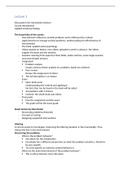College aantekeningen
Social environment and behavior lecture notes and notes of extra videos
The summary contains all lecture notes of the second year course Social and environmental psychology. The notes were made in preparation of the exam in the study year 2021/2022, they contain all the figures and tables as used in the lecture. Additionally, all the extra video material is included in...
[Meer zien]




